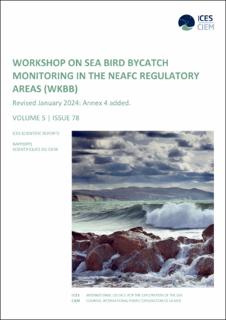| dc.contributor.author | Kingston, Allen | |
| dc.contributor.author | Campbell, Neil | |
| dc.contributor.author | Clark, Bethany L. | |
| dc.contributor.author | Hornborg, Sara | |
| dc.contributor.author | Martinez, Roi | |
| dc.contributor.author | Mateo, Maria | |
| dc.contributor.author | Ono, Kotaro | |
| dc.contributor.author | Rouxel, Yann | |
| dc.contributor.author | Tarroux, Arnaud | |
| dc.contributor.author | Verutes, Gregg | |
| dc.contributor.editor | Glemarec, Gildas | |
| dc.contributor.editor | Bærum, Kim Magnus | |
| dc.date.accessioned | 2024-01-26T09:54:32Z | |
| dc.date.available | 2024-01-26T09:54:32Z | |
| dc.date.created | 2024-01-19T12:25:25Z | |
| dc.date.issued | 2024 | |
| dc.identifier.uri | https://hdl.handle.net/11250/3114049 | |
| dc.description.abstract | In 2021, ICES received a special request for advice from the North-East Atlantic Fisheries Commission (NEAFC) on seabird bycatch in the NEAFC regulatory areas (RAs). Data scoping exercises conducted in 2021, 2022, and 2023 on the availability of bycatch data in the region on the one hand and on the availability of fisheries data on the other hand concluded of important shortages both in terms of quality and quantity that prevented in-depth analyses of the magnitude and the scale of the seabird bycatch problem in the NEAFC RAs. The Workshop on seabird Bycatch monitoring in the NEAFC regulatory areas (WKBB) was the next step in the NEAFC special request. This report describes the work undertaken at the WKBB workshop that took place in Copenhagen and online in May 2023, presents a synthesis of the analytical outputs (including conclusions), and provides some recommendations for the scope and implementation of a pilot monitoring programme which will significantly improve the evidence base related to the incidental bycatch of seabirds in commercial fisheries operating in the NEAFC RAs. The data at hand for the workshop – fisheries effort and two complementary seabird tracking datasets – were used to estimate the spatiotemporal overlap between seabirds and fishing activities in the period 2018-2022. Following this, a bycatch risk assessment method originally developed for marine mammal bycatch (called ByRA) was adapted to estimate risk scores and to map high-risk areas for 20 seabird species susceptible to bycatch in the NEAFC RAs. The results are discussed, including the uncertainty in the data used during the workshop. Based on the results from the ByRA, the last part of the report presents recommendations for a pilot monitoring study to increase the understanding of the scale and of the magnitude of seabirds fisheries interactions in the NEAFC RAs. | |
| dc.language.iso | eng | |
| dc.publisher | International Council for the Exploration of the Sea (ICES) | |
| dc.relation.ispartof | ICES Scientific Reports | |
| dc.relation.ispartofseries | ICES Scientific Reports | |
| dc.title | Workshop on seabird bycatch monitoring in the NEAFC regulatory areas (WKBB) | |
| dc.title.alternative | Workshop on seabird bycatch monitoring in the NEAFC regulatory areas (WKBB) | |
| dc.type | Research report | |
| dc.description.version | publishedVersion | |
| dc.subject.nsi | VDP::Zoologiske og botaniske fag: 480 | |
| dc.subject.nsi | VDP::Zoology and botany: 480 | |
| dc.source.pagenumber | 107 | |
| dc.source.volume | 5 | |
| dc.source.issue | 78 | |
| dc.identifier.cristin | 2230275 | |
| cristin.ispublished | true | |
| cristin.fulltext | original | |
